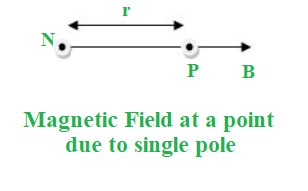磁化强度和磁强度
我们小时候都玩过磁铁。我们中的一些人现在甚至和他们一起玩!是什么让它们具有磁性?为什么不是所有材料和物质中都有磁场?你有没有想过?本章将介绍磁化和磁强度的主题。
磁化
Magnetization is caused by a magnetic moment, as we all know. This is caused by the mobility of electrons in atoms. The response of a substance to an external magnetic field determines its net magnetization.
如前所述,它还考虑了材料由于其电子的迁移率而可能具有的任何不平衡的磁偶极矩。磁化的概念有助于根据材料的磁性对材料进行分类。
We’ll learn more about magnetization and the idea of magnetic intensity in this part. The arrangement of the atoms inside a material determines a magnet’s magnetic behaviour. This is what we’ll be discussing in this article. The magnetization (M) of the material is equal to the net magnetic moment per unit volume of that material.
In terms of mathematics,
M = mnet ⁄ V
Let’s take a look at the case of a solenoid. If we consider a solenoid with n turns per unit length and a current I flowing through it, the magnetic field in the solenoid’s interior may be expressed as,
B0 = μ0 n I
where, µ0 is the constant permeability of a vacuum.
If we fill the solenoid’s inside with a non-zero magnetization material, the field within the solenoid must be higher than before. Inside the solenoid, the net magnetic field B may be written as,
B = B0 + Bm
where, Bm is the field provided by the core material.
It is proportional to the material’s magnetization in this case. In terms of mathematics,
Bm = μ0 M
Let us now look at another concept: a material’s magnetic intensity. A material’s magnetic intensity can be expressed as,
H = (B ⁄ μ0) − M
The total magnetic field may alternatively be defined as, as shown by this equation.
B = μ0 (H + M)
H denotes the magnetic field owing to external variables such as the current in the solenoid, whereas M denotes the magnetic field due to the nature of the core. The latter amount, M, is influenced by external factors and is given by.
M = χ H
where, χ is the material’s magnetic susceptibility.
Magnetic susceptibility is a measurement of a material’s reaction to an external field. For paramagnetic materials, the magnetic susceptibility is small and positive, while for diamagnetic materials, it is tiny and negative.
Substitute the value of M in the equation of B.
B = μ0 (H + χ H) = μ0 (1 + χ) H
= μ0 μr H = μ H
Here, μr is the relative magnetic permeability of the material which is comparable to the dielectric constants in electrostatics. The magnetic permeability is defined as follows:
μ = μ0 μr = μ0 (1 + χ)
磁场强度
The arrangement of the atoms inside a material determines a magnet’s magnetic behaviour. When a ferromagnetic substance is subjected to a strong external magnetic field, it experiences a torque, which causes the substance to align itself in the direction of the applied magnetic field and therefore become strongly magnetised in that direction.
将单位北极置于磁场中时所受到的力被描述为该位置的磁场强度。由于单极,P 处的磁场强度由下式给出:

我们认为,磁场 B 可以表示为:
B = (μ 0 ⁄ 4 π) (m / π r 2 )
我们知道,μ0 ⁄ 4 π = 10 −7
⇒ B = 10 -7 × (m / π r 2 )
其中,m 是极点强度。
磁铁在不同点的磁场强度
- 在纵向位置

+⁄-m 分别是南极和北极的大小。 r 是点 P 到磁铁中心的距离。条形磁铁的长度用字母 l 表示。 P点的磁场强度由下式给出:
B = (μ 0 ⁄ 4π) (2M r ⁄ r 2 − l 2 )
其中,M 是磁矩,(2ml) 是磁矩的长度。
对于小磁铁,r 2 >> l 2 :
B = (μ 0 ⁄ 4π) (2M ⁄ r 3 )
- 在横向位置

P点的磁场强度由下式给出,
B = (μ 0 ⁄ 4π) (M ⁄(r 2 + l 2 ) 3 ⁄ 2 )
对于小磁铁,r 2 >> l 2 :
B = (μ 0 ⁄ 4π) (M ⁄ r 3 )
⇒ B ∝ 1 ⁄ r 3
磁化强度的定义
When a magnet is put in a magnetic field, it changes its magnetic moment. The Intensity of Magnetisation is defined as the change in the magnetic moment per unit volume.
磁化强度的公式如下:
I = M / V
磁矩, M = mx
体积, V= A x
⇒ I = mx ⁄ A x = m ⁄ A
在哪里,
- m 是极点强度,
- A是横截面积,
- x 是磁铁的长度,&
- I 是磁化强度。
示例问题
问题1:磁强度和磁化强度有什么区别?
回答:
The magnetic intensity of a magnet specifies the forces experienced by its poles in a magnetic field, whereas the intensity of magnetization explains the change in a magnet’s magnetic moment per unit volume.
问题 2:您所说的“感应磁化”究竟是什么意思?
回答:
Induced magnetization is a method of making a non-magnetic substance magnetic. When you put it under the influence of an external magnetic field, you may do so.
问题3:磁场强度的公式是什么,是什么意思?
回答:
The magnetic field strength at a particular place can be expressed as a vector quantity known as the magnetic intensity, abbreviated as H. Letter H, on the other hand, equals nI. The magnetic intensity unit is given as A ⁄ m, and its dimensions are [L−1M0T0I1].
问题四:磁场强度的定义是什么?
回答:
The magnetic moment per unit volume of the magnetised material is stated to be defined as the intensity of magnetism, thus we may write it down as I = M ⁄ V, where M is the total magnetic moment inside volume owing to the magnetising field.
问题 5:什么是感应磁化,它是如何工作的?
回答:
The process of causing a non-magnetic substance to become magnetised by exposing it to an external magnetic field is known as induced magnetisation.